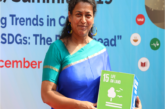The Bonn Climate Change Conference took place from 14 to 25 May 2012 in Bonn, Germany. The conference comprised the 36th sessions of the Subsidiary Body for Implementation (SBI) and the Subsidiary Body for Scientific and Technological Advice (SBSTA). It also included the 15th session of the Ad Hoc Working Group on Long-term Cooperative Action under the United Nations Framework Convention on Climate Change (AWG-LCA), the 17th session of the Ad Hoc Working Group on Further Commitments for Annex I Parties under the Kyoto Protocol (AWG-KP) and the first session of the Ad Hoc Working Group on the Durban Platform for Enhanced Action (ADP).
 Under the SBI, key issues discussed included loss and damage, national adaptation plans (NAPs), and reporting by Annex I and non-Annex I parties. The SBSTA focused on agriculture, research and systematic observation, and methodological guidance on REDD+ (reducing emissions from deforestation and forest degradation in developing countries, and the role of conservation, sustainable management of forests and enhancement of forest carbon stocks in developing countries). Technology and response measures were considered under both the SBI and SBSTA.
Under the SBI, key issues discussed included loss and damage, national adaptation plans (NAPs), and reporting by Annex I and non-Annex I parties. The SBSTA focused on agriculture, research and systematic observation, and methodological guidance on REDD+ (reducing emissions from deforestation and forest degradation in developing countries, and the role of conservation, sustainable management of forests and enhancement of forest carbon stocks in developing countries). Technology and response measures were considered under both the SBI and SBSTA.
Under the AWG-KP, the focus was on issues that need to be finalized to adopt a second commitment period under the Kyoto Protocol  and for the AWG-KP to conclude its work at the eighth session of the Conference of the Parties (COP) serving as the Meeting of the Parties to the Kyoto Protocol (CMP 8). These include: matters relating to quantified emission limitation or reduction objectives (QELROs) with a view to adopting these as amendments to Annex B to the Kyoto Protocol and carry-over of assigned amount units (AAUs). While discussions under the AWG-KP advanced understanding of these issues, many outstanding questions remain, including the length of the second commitment period under the Kyoto Protocol and carry-over of surplus units.
and for the AWG-KP to conclude its work at the eighth session of the Conference of the Parties (COP) serving as the Meeting of the Parties to the Kyoto Protocol (CMP 8). These include: matters relating to quantified emission limitation or reduction objectives (QELROs) with a view to adopting these as amendments to Annex B to the Kyoto Protocol and carry-over of assigned amount units (AAUs). While discussions under the AWG-KP advanced understanding of these issues, many outstanding questions remain, including the length of the second commitment period under the Kyoto Protocol and carry-over of surplus units.
Under the AWG-LCA, parties initially debated the agenda and whether it adequately reflected progress since the adoption of the Bali Action Plan at COP 13 in 2007. After agreement on the agenda, debates continued on which issues require consideration so that the AWG-LCA can finalize its work at COP 18 in Doha. Developed countries stressed “significant progress” and the various new institutions established in Cancun and Durban. They called for a focus on specific tasks mandated by Decision 2/CP.17 (Outcome of the work of the AWG-LCA). Developing countries identified the need to continue discussing issues, such as finance, technology, adaptation, capacity building and response measures in order to fulfill the mandate in the Bali Action Plan.
Under the ADP, discussions centered on the agenda and election of officers. After nearly two weeks of discussions, the ADP plenary adopted the agenda and agreed on the election of officers during the final day of the conference.
At the close of the Bonn Conference, many felt that the atmosphere had been “tense,” especially under the ADP. They expressed hope that this would not have a lasting impact, putting at risk efforts to rebuild trust in the process over the past two years since Copenhagen and the “delicate balance” of interests reflected in the Durban Package.
Broadly speaking, UN preparatory meetings, such as the one in Bonn, seldom get much attention from the mainstream media, because they tend to be technical, no prominent political leaders take part, and as a result there are rarely any sound bites for the media.
However, this time it was different because, shortly after this meeting a major summit of UN Sustainable Development, Rio+20, will be held.
The 1992 summit in Rio de Janeiro was a turning point in global awareness for several reasons. Major environmental law documents were produced – the Rio Declaration, a Global Policy of Sustainable Development for the 21st Century, and Agenda 21 – and two important global framework conventions on climate change and biological diversity were agreed upon. The Earth Summit was by far the biggest international conference ever convened. More than 100 heads of states took part. Rio+20 will not be nearly as successful.
 Many things have changed since 1992. Most importantly, climate change has been recognised as a dangerous threat to human security caused in large part by human activity. This threat is gradually entering our daily life. Concurrently, geopolitical, economic and technological competition among the old guard economies and new members of world society has become boisterous.
Many things have changed since 1992. Most importantly, climate change has been recognised as a dangerous threat to human security caused in large part by human activity. This threat is gradually entering our daily life. Concurrently, geopolitical, economic and technological competition among the old guard economies and new members of world society has become boisterous.
This is what makes the Bonn talks so significant. The people should follow what is going on there. During the last few years, the multilateral UN talks to reduce greenhouse gas emissions (GHG) so as to lessen the major impact of climate change’s adverse effects, degenerated into a kind of international contest between developing and developed countries, doing nothing to reduce emissions while blaming each other for the failure.
The people who initiated these talks in the early 1990s are no more on the scene and a new generation has arrived, new political leaders emerged, and different ideological perspectives have gained prominence. More importantly, geopolitical balances have become more complicated. The geopolitical map is far more complex than two decades ago, almost giving rise to nostalgic feelings of fondness for the Cold War era of stable bipolarity.
The sharp division between developed and developing countries no longer describes environmental diplomacy, although it continues to exist on paper. China’s emergence as a leader gives it global legitimacy among the countries of the South. India and Brazil are still developing countries, but their ambition is not associated at this time with asserting claims of global leadership. Their robust economic growth in recent years does make them eager to play a leadership role.
Yet they are not willing to give up their growth-oriented economic policies easily, and their internal economic challenges remain enormous, especially mass poverty. Voices advocating policies beneficial for the developing world are still not strong enough to ensure that the developed world continues to uphold legally binding commitments.
This was demonstrated at the recent Durban meeting. There are also emerging mid-income developing countries, including Mexico, Turkey, South Africa and South Korea, trying to find their own comfort zone, reflecting their particular national interests. Meanwhile, the 48 Least Developed Countries (LDCs), 33 of them in Africa, are becoming a voice of the voiceless, as the UNFCCC gives them more rights than others in relation to climate change commitments. These countries are the most victimized by the threats posed by climate change, despite beng the least responsible for the buildup of greenhouse gases.
Looking Ahead
Bonn demonstrated that, as many have said, Durban was a carefully negotiated package contingent on all elements of the outcome moving forward in tandem. However, what is clear is that parties have a very different perspective of what the future looks like in terms of, inter alia, the ADP’s mandate, how to terminate the AWGs and what to focus on for effectively addressing climate change. As evidenced in Bonn, constructive ambiguity results in uncertainty that can sometimes breed mistrust. This mistrust is often manifested through disputes over procedure and consequently hampers progress.
Looking ahead, parties have their work cut out to accomplish tasks they agreed to in Durban. They will need to exercise goodwill, integrity and congeniality in order to deliver on the ultimate objective of meaningful mitigation action for the post-2012 era.
There have emerged new questions and diplomats are not equipped to answer them properly. It needs philosophical and ethical understanding, responsible leadership, and in the end, public-spirited and globally oriented solutions. The most vexing question today is: how long can we expect to keep ourselves safe and secure behind man-made walls as we face the perils of climate change?



